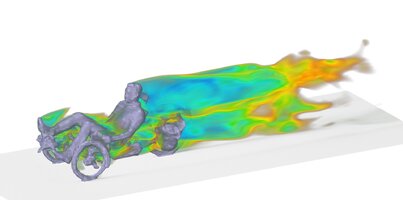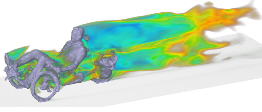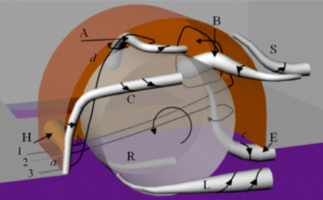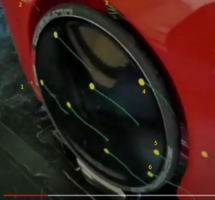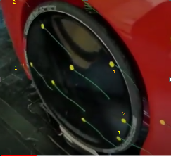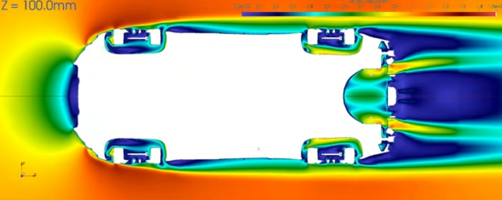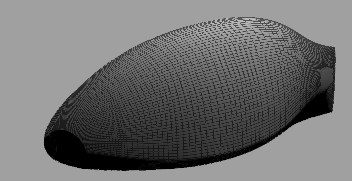I had hoped that Michael or someone similar who is using modern CFD tools would start this thread, but maybe we just need to start. I have some understanding of aerodynamics but no practice with full CFD. We need one or two people with CFD experience to keep an eye on this thread.
This could be a place to share on CFD applied to velomobile design. Results, notes on the method, limitations, opportunities...
Bt first...(hoooooot sounds)

The little icon with the medieval trumpet signals that we should just bring our technical (A-) game and leave our social dysfunction, misgivings and pessimism at the door.
To begin...Just noticed this interesting velomobile CFD sim by Christof Gebhardt (carouso) https://www.e-moped.net/2019/12/07/wie-strömt-s/
A snapshot from the video...
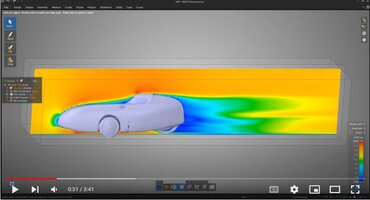
Recently discussed here (in the usual diffuse manner)... https://www.velomobilforum.de/forum...aler-windkanal-windlast-auf-velomobile.57642/
After post #14
I find this study very interesting and useful. Well done Christof. And it is really encouraging how blindly fast it was to acquire the model surface, then prep and run the CFD. I was a bit pleasantly shocked..Christof describes "from the 3D scan to the geometry preparation to the result - took about 2 hours"
I'm sure he will answer some questions about how the meshing can be so automatic, or about the analysis tool....
I interpret the "road" as being just a stationary part of the "tunnel" walls. And there looks like no flow interaction with the wheel wells, and the wheels are not rotating. But, two hours..!
So my happily naive instincts tell me that a more detailed model with moving road and rotating wheels, maybe even realistic internal flow...could be legitimately within reach for a small indie velomobile design exercise.
Returning to the video of Christof's flow sims. I don't believe that a more explicit model will change the observations I'm about to make very much. And these thoughts, with a little familiarity with aero, are fairly obvious. Even with uncertainties, one can learn much...
I snapped that screen shot because it was a fair illustration of what I thought it was telling me. I think colors in the video are always showing the relative velocity. This dark blue shows V=0 or close to it. The "separated" volume behind the body is quite large. I'm guessing it contains an unstable system of vortices that keep shedding.
The streamlines that I saw enclose that separated volume. Someone with more experience may know if the spiraling streamlines are a sign of the shedding vortices, or somehow caused by the shape of the rear of the body. I can't change my view to see if there are symmetric left and right spiraling streamlines.
Ideally, the afterpart of the body should manage the pressure recovery and separation should occur at the trailing edge (TE). In the sim, the flow is separating from the surface well before the TE. Look at time 03:21 where a vertical slice showing velocity distribution shifts laterally and you can see the extent of separation.
To be clear, any blue air is almost stationary in this virtual wind tunnel. In real life it is being dragged along with the body. For less drag, minimize that. The shape of the whole body plays a part in this. The way that pressure gradients over that shape culture the boundary layer (BL).
The other two obvious areas with V=0 are the stagnation point at the nose (file that for a separate optimization issue) and the base of the windscreen. The flow is not happily traversing this abrupt curvature or break. You can see from the V distribution, the likely shape that it would prefer to flow over.
Because the canopy shape (fairing over the pilots head) is tallish and narrow, the streamlines tend to go around rather than over it. So it could have a shape that allowed that better. And or bigger fillets all round that shape.
Some residual thoughts after this...Maybe there are a few people with interest, skills and access to FLUENT (ANSYS now own FLUENT) and the machine time is not as long as some (including me) fear. Maybe some studies can even be done on a free student license. There are definitely a lot of people with skills to produce the surface definition.
The issue remains, where best to direct this energy. I am not in favor of doing a lot of comparative studies on the existing velomobiles. I'm interested in new ideas, and one or two of the existing bikes. Most interesting existing velo is the Go One Evo R. And the new Bulk. They are both careful refinements of almost opposite ideas.
I believe that sofar velo designers are a bit careless about the boundary layer. But imagine a version of the Evo R that could keep laminar over 60% of its length. It will gain a little frontal area doing that, mostly to enclose the wheels.
Gregg....
This could be a place to share on CFD applied to velomobile design. Results, notes on the method, limitations, opportunities...
Bt first...(hoooooot sounds)

The little icon with the medieval trumpet signals that we should just bring our technical (A-) game and leave our social dysfunction, misgivings and pessimism at the door.
To begin...Just noticed this interesting velomobile CFD sim by Christof Gebhardt (carouso) https://www.e-moped.net/2019/12/07/wie-strömt-s/
A snapshot from the video...

Recently discussed here (in the usual diffuse manner)... https://www.velomobilforum.de/forum...aler-windkanal-windlast-auf-velomobile.57642/
After post #14
I find this study very interesting and useful. Well done Christof. And it is really encouraging how blindly fast it was to acquire the model surface, then prep and run the CFD. I was a bit pleasantly shocked..Christof describes "from the 3D scan to the geometry preparation to the result - took about 2 hours"
I'm sure he will answer some questions about how the meshing can be so automatic, or about the analysis tool....
I interpret the "road" as being just a stationary part of the "tunnel" walls. And there looks like no flow interaction with the wheel wells, and the wheels are not rotating. But, two hours..!
So my happily naive instincts tell me that a more detailed model with moving road and rotating wheels, maybe even realistic internal flow...could be legitimately within reach for a small indie velomobile design exercise.
Returning to the video of Christof's flow sims. I don't believe that a more explicit model will change the observations I'm about to make very much. And these thoughts, with a little familiarity with aero, are fairly obvious. Even with uncertainties, one can learn much...
I snapped that screen shot because it was a fair illustration of what I thought it was telling me. I think colors in the video are always showing the relative velocity. This dark blue shows V=0 or close to it. The "separated" volume behind the body is quite large. I'm guessing it contains an unstable system of vortices that keep shedding.
The streamlines that I saw enclose that separated volume. Someone with more experience may know if the spiraling streamlines are a sign of the shedding vortices, or somehow caused by the shape of the rear of the body. I can't change my view to see if there are symmetric left and right spiraling streamlines.
Ideally, the afterpart of the body should manage the pressure recovery and separation should occur at the trailing edge (TE). In the sim, the flow is separating from the surface well before the TE. Look at time 03:21 where a vertical slice showing velocity distribution shifts laterally and you can see the extent of separation.
To be clear, any blue air is almost stationary in this virtual wind tunnel. In real life it is being dragged along with the body. For less drag, minimize that. The shape of the whole body plays a part in this. The way that pressure gradients over that shape culture the boundary layer (BL).
The other two obvious areas with V=0 are the stagnation point at the nose (file that for a separate optimization issue) and the base of the windscreen. The flow is not happily traversing this abrupt curvature or break. You can see from the V distribution, the likely shape that it would prefer to flow over.
Because the canopy shape (fairing over the pilots head) is tallish and narrow, the streamlines tend to go around rather than over it. So it could have a shape that allowed that better. And or bigger fillets all round that shape.
Some residual thoughts after this...Maybe there are a few people with interest, skills and access to FLUENT (ANSYS now own FLUENT) and the machine time is not as long as some (including me) fear. Maybe some studies can even be done on a free student license. There are definitely a lot of people with skills to produce the surface definition.
The issue remains, where best to direct this energy. I am not in favor of doing a lot of comparative studies on the existing velomobiles. I'm interested in new ideas, and one or two of the existing bikes. Most interesting existing velo is the Go One Evo R. And the new Bulk. They are both careful refinements of almost opposite ideas.
I believe that sofar velo designers are a bit careless about the boundary layer. But imagine a version of the Evo R that could keep laminar over 60% of its length. It will gain a little frontal area doing that, mostly to enclose the wheels.
Gregg....
Zuletzt bearbeitet von einem Moderator:


